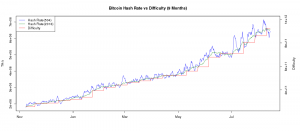
After rocketing to an all-time high of almost $20,000 in 2017, Bitcoin prices have plummeted since the 17th December.
The collapse has caused critics to crawl out the woodwork claiming the inevitable bubble has burst. Mainstream media has rubbed salt into the wounds by labelling the Bitcoin crash a “bloodbath”.
But the cryptocurrency community is unperturbed. Some are still wondering if the Bitcoin Crash will continue, but in reality, you shouldn’t actually care.
The call of HODL (Hold On for Dear Life) can be heard loud and clear; the blockchain faithful knows crypto assets are the solution to financial stability.
We live in the digital age. It is inevitable that mainstream currencies will be integrated into the digital environment.
The price of Bitcoin may have fallen again since that brief flicker of a recovery, but if you have already invested in cryptocurrency, there is no cause for alarm. A fall in price throughout January is nothing new for Bitocin.
As a matter of fact, the Mother Coin has suffered deficits in four of the last five January windows. After 2017’s extraordinary bull market, Bitcoin prices needed slowing.
What we see here is a market correction. The long-term viability of Bitcoin as an alternative currency to the current fiat system is inevitable.
Nicholas Gregory, CEO of CommerceBlock, a company that helps businesses set up cryptocurrency transactions said:
“Once Bitcoin starts to behave more in tune with traditional foreign exchange markets, people’s faith in it will only grow.”
Bitcoin Price Analysis
After falling as low as $6000, Bitcoin prices have been edged back to between $8000-$9000. A breakdown of these trends indicates the leading cryptocurrency could be gearing up for another bull run.
On the other hand, there are signs that the correction is not over yet.
Analysts are undecided whether the bear market has bottomed out or whether Bitcoin prices will stabilise.
First of all, there is a resistance on the 1-day 200 EMA for the first time since the end of the last bear market in 2015.
The Directional Movement Index (DMI) and the 4-hour chart indicated an equilibrium between buyers and sellers. Activity in the last few days has revealed there are more sellers than buyers.
The second notable trend is a drop in the overall volume since the price bottomed out at $6000. This indicates buyers are losing interest in prices between $8000-$9000.
That’s a red flag the bear market could continue. Bullish rallies coupled with low volumes usually mean a further fall in prices.
How Did Recent Cryptocurrency Scams Affect The Bitcoin Crash?
Mainstream media love to stir up fears of investing in cryptocurrencies.
Market regulators are forever issuing warnings to investors that buying Bitcoin and other cryptocurrencies have a high risk of fraud and manipulation.
Recent history shows critics have a point. So do critics of the current financial institution.
Facebook has reacted to the latest Bitcoin scandal by banning cryptocurrency ads on its network because they are “frequently associated with misleading and deceptive promotional practices.”
The cryptocurrency market is not void of scams.
Traders can make huge amounts of easy money in a short space of time. Careless investors will get stung.
A recent example is a case of “Prodeum”, a new digital asset that lasted all of four days before disappearing.
It is not known how much the orchestrators made, but that doesn’t bother mainstream media from trashing the whole shebang as a scam.
Of course, there have been some high-profile cases where the perpetrators made off like Bernie Madoff.
Bitconnect was shut down several weeks ago after regulators acted on suspicions the exchange was running a Ponzi scheme. The owners of the company are unknown and appear to have embezzled $2 million worth of investors’ money.
The Bitcoin scandal draws parallels with Mt. Gox that claimed to have been hacked in 2014.
Although the owner, Mark Karpeles, is standing trial on charges of embezzlement in Japan, experts expect the mastermind will walk away with a windfall of $859m even once the funds owed to creditors are paid back.
Investing in cryptocurrencies is a risk – but so are many other forms of financial trading. Investors should always perform due diligence before putting their money into a third party fund.
However, it is evident that cryptocurrency investors have been swept up in the storm and are prepared to back any cryptocurrency that is said to show promise.
A good example is “PonziCoin” launched by San Francisco-based software developer Rishab Hegde.
The website described the coin as “the world’s first legitimate Ponzi scheme” but admitted in the FAQ’s that PonziCoin was a joke.
It seems nobody read the FAQ’s and backed the coin anyway. Hegde eventually shut it down because the joke had “gotten out of hand.”
Although mainstream media and CEO’s of financial institutions want the general public to think all cryptocurrency investments are a scam, it seems the general public is not too concerned by this scaremongering.
Bitcoin rallied to over $9000 last week, suggesting investors have very short memories or are ignoring bankers and their media mouthpieces.
The Impact Of The Government Regulations
While reports of Bitcoin scams may be unsettling for the cryptocurrency market, fraudulent activities do not cause the significant price fluctuations as the meddling of governments and banks.
In the past year, government threats have been followed up with actions.
Subsequently, once-thriving cryptocurrencies such Bitcoin, Ethereum, Litecoin and Ripple have seen double-digit losses.
China is the chief enforces. Last summer, the authorities issued bans on ICOs and shut down domestic exchanges.
The ban was recently extended to international markets. The reasons cited for the crackdown are to “cleanse financial risk,” and money laundering.
China is home to the most significant community of Bitcoin miners and calling a halt on digital assets has stifled the market. The so-called “Great Firewall of China” is arguably the biggest cause of the Bitcoin crash.
However, the ban is not expected to last once regulations are in place. Or when the People’s Bank of China launches their cryptocurrency.
In case you didn’t know, China’s central bank is working on a prototype to develop its cryptocurrency.
They were the first major bank to take steps towards taking full control of digital transactions. Central banks across Europe, together with national Mints are also launching a virtual coin.
Given banks are developing their virtual currencies; it could spell an end to the libertarian aspirations of Bitcoin.
However, the authorities have no right to steamroll the cryptocurrency community, and any attempts to do so will be met with a backlash from voters.
Banks in the US, together with Lloyds Banking Group in the UK are the latest to spook the market by issuing bans on credit card purchases of cryptocurrency.
Investors can still buy digital assets through PayPal and over the counter transactions, but this process is slower and raises issues over security.
Expert analysts suggest the US Federal Reserve could “kill” Bitcoin altogether.
Because Bitcoin has no fixed amount, the Fed can claim they can’t engage digital assets in monetary policy because they have no control over the increase or decrease of the supply.
Was it a “Pump And Dump”?
Warnings of Bitcoin bubble have been prevalent throughout the financial sector.
Few commentators mention the Bitcoin crash is due to a pump and dump – a market manipulation tactic that causes prices to rise suddenly before taking a dramatic fall.
The trend in Bitcoin prices fit a pump and dump protocol.
In the UK, the Express newspaper report Bitcoin expert Ryan Derks compares the collapse of Bitcoin to a guitar string.
“When you pull a guitar string too high, it doesn’t just go to back to neutral, it has to release all of that excess energy. So what we’re seeing right now, in my opinion, is a lot of that excess energy falling out.”
Like many other financial commentators, Derks believes too much buying caused the price of Bitcoin to rise too fast that it was not sustainable. “It had to come down,” he said.
While Bitcoin prices do bear the hallmarks of a pump and dump, the crash could come equally due to a market correction.
But are they one in the same?
A lack of regulation was the most probable cause of the Bitcoin bubble. But the lack of control allows for investors with insider knowledge and the capital to buy large volumes of Bitcoins and manipulate the market with unscrupulous trading practices that are illegal in regulated markets.
An investigation published in Business Insider last November revealed Wall Street scams were rife in the cryptocurrency market.
The report claims traders using US exchanges, Bittrex and Bitfinex deliberately inflate the price of virtual currencies to make a quick profit.
While large scale tactics would cause Bitcoin to crash, traders typically choose to pump and dump altcoins that show promise. Once prices surge, the pumpers sell off their high volumes of shares and cash in on high prices at the expense of second-wave investors.
Bitcoin prices were already at $750 in January 2017. That is comparatively high to most other altcoins.
Ethereum, for example, was under $11. Would it be possible to pull off a pump and dump of this magnitude?
A scam of that size would be ambitious. But if the group of pumpers had enough Bitcoin between them it could happen. It doesn’t seem very likely, but a lot of wealthy investors that adopted Bitcoin in the early days did make a lot of money.
Just saying.
The latest crash is due to panic selling.
When Is The Cryptomarket Going To Recover?
Volatility in the cryptocurrency market is nothing new.
Bitcoin may have lost all-time highs in the last month, but that’s only because prices reached all-time highs in December. Equally spectacular falls usually accompany spectacular climbs.
Expert analysts – and the entire cryptocurrency community of course – expect Bitcoin to recover.
Ironically, a recovery will be prompted by market regulation. Banks may be the dynamo behind the “bloodbath”, but it will be Government regulators that tidy up the mess.
The current state of the market and the future recovery is a classic case of cause and reaction. Market manipulators create a problem and government puppets “come up” with a solution. This is how laws have been written for millennia.
The level of recovery will depend on how much fraudulent trading activities laid the foundations for Bitcoins steep price rise.
If Bitcoin was a pump and dump scam, the perpetrators have already pulled out and made away with their ill-gotten gains.
Regulation will restore faith in the market, even if it doesn’t drag Bitcoin back to its 2017 high surge.
Any increase in Bitcoin prices will be gradual. But an increase is inevitable.
Analysts still have faith the Mother Coin will surpass her all-time high and break the $20,000 threshold.
The bottom line is consumers need protecting. This large short-term correction is just the start of bringing in the widespread adoption of cryptocurrencies.
The Future Price Of Bitcoin
Regulations may stabilise the cryptocurrency market, but they may also level out prices at the bear market value.
However, mass adoption of cryptocurrencies will mean profits can be made in the virtual token space.
Billions of dollars have already been invested in the blockchain, and it seems almost inevitable that financial institutions will adopt the technology that is behind the drive towards a mass of adoption of virtual currencies.
The dark cloud that hovers over Bitcoin’s future is how much banks are prepared to loosen the control they have on financial markets.
It’s doubtful the banks will hand over control to public ledgers so easily, but with the impending crash of fiat currencies, virtual coins provide a solution to the problems banks (and the government officials they pay to turn a blind eye) have created.
But it is the blockchain eco-system the banks are interested in; and it is the technology, not the coins that will determine how lawmakers choose to integrate virtual currency into the public arena.
In the meantime, the Bitcoin value will inevitably recover, so stop worrying if Bitcoin crash continues, and read our Bitcoin price prediction for 2018.



![Bitcoin Buyer Review of Official Website [2022] bitcoin buyer review featured image](https://bitemycoin.com/wp-content/uploads/2022/04/bitcoin-buyer-review-featured-218x150.jpg)
![Bitcoin Digital | Official Website Review [2022] bitcoin digital review featured](https://bitemycoin.com/wp-content/uploads/2022/04/bitcoin-digital-featured-218x150.jpg)






